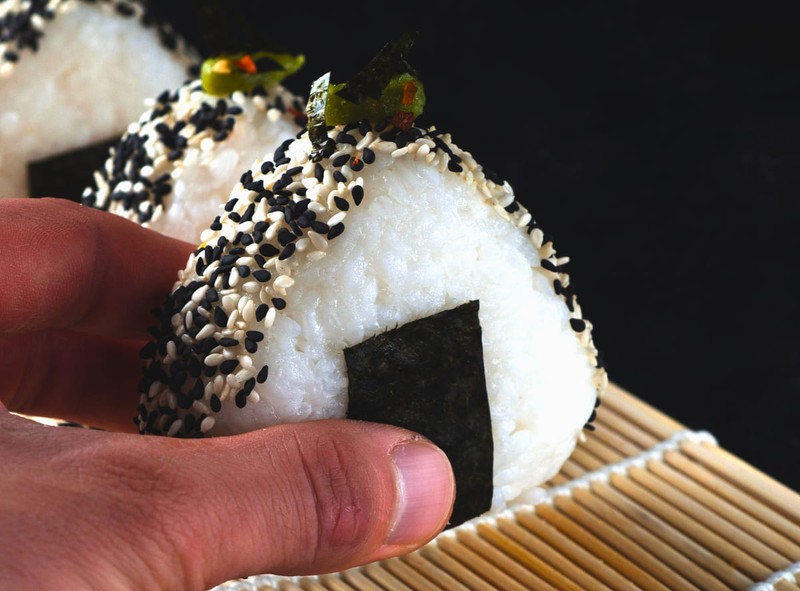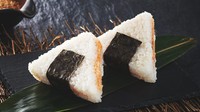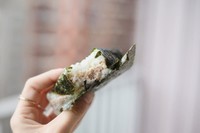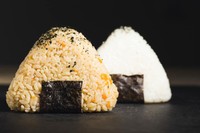How to make onigiri?
In this article, we will see how to make onigiri without failing once. We will learn the most basic and simple rules. All you need is cooked rice and excellent quality nori seaweed.

Table of contents
- Japanese short grain rice
- The nori leaves
- The different forms and variations of onigiri
- How to wrap the onigiri with the nori leaves?
- The five tips to have a perfect onigiri
- Use freshly cooked rice
- Wet and salt your hands
- Give just enough pressure
- Identify your rice dumpling with a filling
- Wrap the nori before eating
- Quick and easy onigiri recipe
Japanese short grain rice
Called sushi rice outside Japan, Japanese short grain rice is the rice we use in most Japanese cuisines. It gives you the perfect soft, tender and slightly sticky texture. Please do not substitute it with any other type of rice, as the onigiri will not hold.
The nori leaves
This is the same seaweed wrap we use to wrap sushi. You can find it in Asian grocery stores, supermarkets or online.
The different forms and variations of onigiri
The shape of the onigiri is important because it is the shape that makes it convenient and easy to eat. The most common shapes are as follows:
- Triangular
- Cylindrical (rice ball shape)
- Round or circular
- Cylindrical
- Creatively, some cooks shape the rice balls into cute animals or character-based shapes.
How to wrap the onigiri with the nori leaves?
Cut a nori sheet into thin strips and wrap the nori around the cylindrical or triangular rice ball shape. You can also cut the nori sheet into thirds and wrap the rice ball with the nori. Be careful, wrapping your onigiri when it is hot will damage your nori, it will soften and lose its iodized taste.
You can buy a plastic onigiri wrapper that allows you to keep the nori crisp until you are ready to eat.
The five tips to have a perfect onigiri
Use freshly cooked rice
I strongly recommend using freshly cooked rice instead of older rice when making onigiri. Indeed, rice oxidizes quickly, so it loses its taste and hardens.
To keep the rice as long as possible, keep your onigiri covered with plastic or a wet towel so that the rice does not dry out quickly.
Wet and salt your hands
It is important to wet your hands with water to prevent the rice from sticking. Have a bowl of water ready next to your workstation. Salt both hands and rub it around. The salting helps to flavor and preserve the onigiri longer.
Give just enough pressure
Your hands should be just firm enough when you press the onigiri so that the rice does not collapse when you shape it. You don't want to squeeze the rice too tightly. You rotate the rice balls as soon as you apply a little pressure. After turning 3 to 5 times, the rice ball should be in good condition.
Identify your rice dumpling with a filling
If you are adding a filling, be sure to place a small amount of filling on the rice ball (such as on a tip of the triangular shape) so you can identify which filling is inside.
Wrap the nori before eating
Do not wrap your onigiri in advance. The nori leaves absorb the water in the rice, so the nori will get wet, soften and lose its taste.
In the konbini, the rice is separated from the nori leaf, which allows to have a soft and crispy onigiri. A real treat!
Quick and easy onigiri recipe
Informations
- Portions6
- DifficultyEasy
- Total time40 minutes
- Calories200 Calories
Ingredients
- Japanese round rice300 g
- Salt1 tea spoons
- Nori leaf1
Utensils
- Coffee spoon1
- Soup spoon1
- Rice cooker (or pan)1
Steps
- Start by washing the rice with clean water. Put the rice in a container and add water. With your hand, stir the rice quickly until the water becomes cloudy. Drain the water and repeat the process four more times until the water is clear.
- Put the rice in a saucepan with twice its volume of cold water. Cover and bring to a boil.
- As soon as the water boils, stir the rice off the heat, reduce to a minimum and cook for 15 minutes, covered.
- Remove from heat and let stand for 10 minutes to allow the rice to swell in its steam.
- Let the rice rest, as it is very hot. Do not let it cool down completely or it will not stick anymore.
- Cut the nori sheet into six wide strips.
- Wet your hands and then generously cover your palms with salt to prevent the rice from sticking to your hands.
- Take some rice in your hands and start by making a ball. Be careful not to crush the rice too much, the grains should stick together but still be full of air. Gradually, give the onigiri the shape you want, usually a triangle.
- Wrap your onigiri in the nori sheet. Make as many balls as you can until you use up all your rice.





